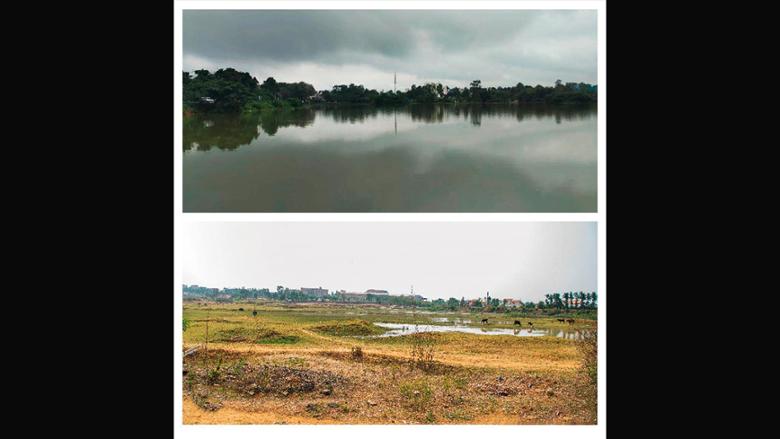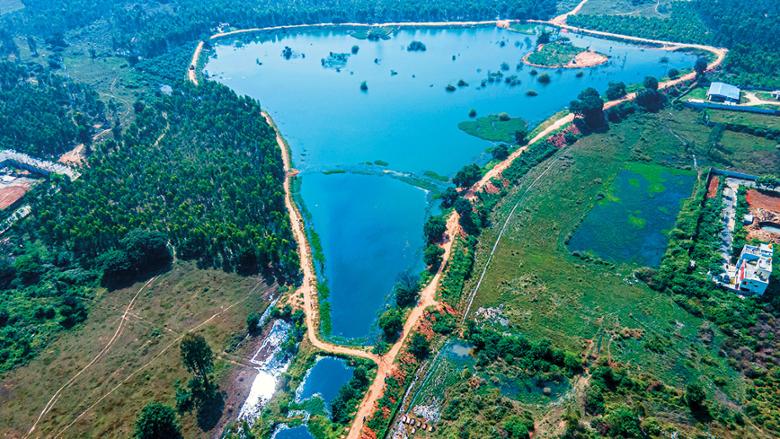Meet the man who is reviving India’s dead lakes
Even as hundreds of water bodies are slowly dying due to natural or man-made conditions, one man in Bengaluru is working hard to resuscitate them. To date he has rejuvenated 12 huge lakes and working on saving several more, finds Reema Moudgil
There is a difference between reductiveness and simplicity. Erstwhile mechanical engineer and lake conservationist Anand Malligavad knows this because as a man on a mission to revive Bengaluru’s water bodies, he refuses to take short-cuts. Instead, he has created an easily replicable, uncomplicated blueprint to offer long-term solutions.
As the 42-year-old says, “Lakes can be revived with cost- and time-effective, ecological and sustainable methods. A blueprint can be created without using too much technical or scientific jargon so that a common man can replicate these ideas to rejuvenate the water bodies in their cities.”
There is a sense of clarity that comes naturally to him so there was no confusion or doubt in his mind when he decided to give up his high-paying job at Sansera Engineering Ltd to focus single-mindedly upon bringing some of the vitiated and dry lakes in Bengaluru, in southern India, to life.
The first lake he revived was in 2017, a year after he began research in the conservation of water bodies. Tasting success, two years later, in 2019, he decided to immerse himself full time into restoring and rejuvenating dying or dried up lakes.
“I had family responsibilities. My daughter is currently studying in Grade 9 and it was not easy to give up the regular monthly pay cheque,” he says. But he decided that the settlement money he would receive when he resigned could help sustain him and his family, and he would use all his energy and time to do what his heart was set up: to revitalise at least 45 lakes by 2025. “I knew I had to do something because Bengaluru, much like Cape Town, in South Africa, is on its way to becoming a zero-water city.”
The tipping point, so to speak, that propelled him to do his bit was the realisation how fast the city’s water bodies had degenerated and how little was being done to revive them.
Initally, Anand spent over a year researching the state of water bodies in Bengaluru, visiting and studying some 180 lakes to learn the ecosystems they once supported, their topography, the condition of the soil in the lake bed and around it...
What he learnt disturbed him immensely. “When I first arrived in Bengaluru in 1996 from Karmudi in rural Karnataka (where he was based), things were different,” he recalls. “Most houses had wells that were barely 10 to 20 feet deep and offered excellent water. There were plenty of trees and the weather was cooler thanks to the green cover and biodiversity. Post the IT boom, pollution, deforestation and construction activities began to increase and lakes began to vanish.”
The first lake he began working on to resuscitate was in April 2017. Through earnest appeals he managed to bring together around 1,800 volunteers who helped him plant trees around the 36-acre Kyalasanahalli Lake in the city. “We managed to finish planting the saplings in just 1 hour and 45 minutes,” he says, still excited by his first major green endeavour. Other measures required to improve the lake were completed and on June 5, World Environment Day, he completed the first phase of reviving the lake. By the first week of September, there was a 95 per cent increase in the water level of the lake. “It was so rewarding to see it brimming with life and in such a short time,” he says.
Today, when Anand talks about the work he has done to green his city, he often uses the term, “my lake” when referring to a specific project. This sense of ownership and accountability perhaps comes naturally to him having grown up in a region close to a river. “My school in Karmudi, was close to a river bed and I have fond memories of spending a lot of time near it exploring its ecosystem,” he says.
Among the lakes he has successfully revived are those in Nagamangala, Vabasandra, Nanjapura, Konasandra, Gavi and Manae. He says, “The smallest lake I have worked on is 3.5 acres, a medum sized lake is around 30 to 40 acres and I am now working on Sadahalli Lake which is over 110 acres.”
The results are achieved via painstaking research and hard work. For instance, he only plants indigenous plant species in keeping with the topography instead of ill-suited exotic species from other countries which will not be able to survive in the local climate and won’t contribute to biodiversity.
Every lake comes with a unique set of challenges, he says. If it is connected to a sewage source, just 15 per cent of the sewage mixing with 85 per cent of rainwater, can contaminate the entire lake.
Anand begins by making arrangements to separate rainwater and sewage water. The next step involves trapping silt and biomass, then purifying rainwater catchments and using a natural, biological sewage treatment.
The purified water is then used for afforestation and for watering saplings.
The removal of sludge and desilting cleanses the water and increases the water holding capacity of a lake. Natural materials like clay, and gravel from the lake itself are used to create bunds and walls of the lake.
If the lake is dry and filled with solid waste, measures are taken to clean it first. Then the waste is segregated recycled, if possible. With the help of desilted mud, islands and walking tracks are created.
Traps are created to prevent plastic from reaching the lake and steps are taken to boost the water holding capacity of the lake bed. Finally, native plant saplings are planted to increase the biodiversity and improve the microclimate. “The lake ideally must have 60 per cent water body and 40 per cent native flora and fauna,” says Anand.
Funding is a challenge
All of this work requires money but funding continues to be a challenge. “Not all companies are serious about causes such as lake rejuvenation or afforestation, and quite a few prefer spending their Corporate Social Responsibility (CSR) funds the easy way on endeavours that can get them publicity,” he bemoans. “On an average, if I present 150 proposals seeking funds, I will get maybe one positive response. Still, with persistent effort, I have convinced around 15 corporate entities to chip in.”
He agrees crowdfunding is another option “though strangely more expats than locals donate to this cause.”
He says, “Lake conservation is not easy and to revive a dead and dry lake, you need over Rs500,000 per acre to do desilting, wall strengthening and natural purification. For a semi-urban lake which is connected with sewage lines and is choked with debris and solid waste, the rejuvenation work would cost around Rs800,000 per acre.”
Anand has rejuvenated 12 lakes in Bengaluru so far, two are works in progress and he has helped local communities to restore four others.
Like everything he does, nothing is left to chance and is planned to the last detail. As he says, “We [my team and I] don’t walk out after restoring a lake but maintain it till it becomes self-sustaining. We also engage communities and companies to help with the maintenance.”
Firm will needed
The absence of a firm societal will to address ecological issues troubles him. “Lakes are not just surface water. They play a vital role in maintaining the ecological balance. They mitigate floods, recharge groundwater, support aquatic life, flora and fauna, provide drinking water for cattle, and revitalise agriculture. Governments should seriously finalise a blueprint to preserve water bodies and, individually, as citizens, we should also start respecting water as an invaluable resource, harvest rainwater, and acknowledge the water scarcity staring at us in the face.”

Right now, his biggest challenges are to get past the stronghold of encroachers and to convince local communities to support his work. “I am an independent lake conservationist. From designing plans, to raising corporate funding, getting clearances, to hiring equipment to execute digging and cleaning, I am a single man helming many fronts. When I engage communities to work with me, I pay them daily wages from the funds that have been raised. But the process is rarely smooth. Encroachers occasionally bring unsavoury elements with them and make threatening calls. These things have now become a common occurrence for me.”
And yet, he persists and says, “When my family sees the results of the efforts I have made and the success of my endeavours, their trust in what I am doing grows. And there are beautiful moments.”
Starting young
He credits his younger days for shaping his character and instilling in him a passion to make a positive difference. “My childhood memories played a big role in shaping my attitude towards the environment. Hence I feel environmental education for kids is important. They must get practical insight into rainwater harvesting and the way storm water drain, stepwells, rivers and oceans contribute to our well-being. They must be taught civic responsibility as they will be our future leaders,” he says.
His next big goal is to use his expertise to clean the Ganga. “I don’t think any effort to directly rejuvenate Ganga can help unless we make sure that the tributaries are maintained and prevented from releasing industrial effluents and sewage into the river.
“As citizens, we must take responsibility for taking care of our water bodies and remember that once water comes out of our taps, it turns into grey water, enters our lakes and water bodies and contaminates them. By being mindful and synergising with like minded people, we can bring about a change.”

